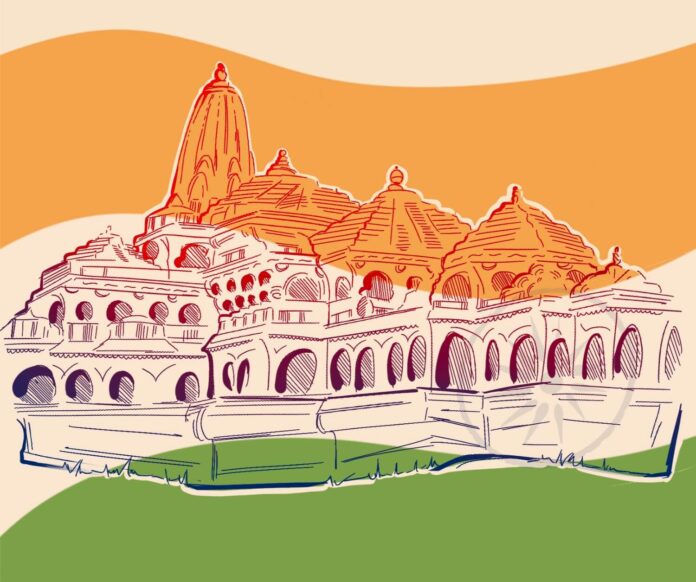When I was a child, my parents would take my brother and me to a Hindu version of Sunday school — Saturdays, from approximately 10 a.m. to 1 p.m., a religious organization rented out a local high school for classes where we would learn about legends, prayers and philosophy to remain connected to the faith. One of these legends was the story of Rama, a worldly incarnation of the preserver god Vishnu, who, after many trials and tribulations, rises to become king of Ayodhya.
I didn’t think much of it up until recently — religion didn’t have an impact on my life outside those classes. However, with the recent consecration and ongoing construction of a positively edificial temple to Rama in Ayodhya, I’m reminded that, while religion wasn’t particularly impactful in my own life, it has power — destructive, deadly power.
On the supposed site of Rama’s birthplace in Ayodhya, a commander named Mir Baqi constructed a mosque dedicated to the Mughal emperor Babur, the Babri Masjid. That a house of worship for a foreign religion, named after a foreign conqueror of the Indian subcontinent, was built on top of the birthplace of one of the holiest figures of Hinduism seemed maximally offensive to many Hindus. However, the historical record is murky — we don’t know where Rama was born, if he even existed, nor does Babur mention the mosque’s construction in his autobiography.
This fuzziness did not faze Hindu nationalist ideologues, who believed that the site of the Babri Masjid belonged to them alone and started agitating for ownership of the site shortly after independence from the British Empire. They desired a temple to Rama in Ayodhya as an integral part of their plan to turn India into a Hindu rashtra, or Hindu nation, to the exclusion of minority religions. There was just one problem — India was created as a secular democracy, enshrined in the constitution, and the idea of an explicitly religious, authoritarian government was distasteful to the newly independent country.
Hindu nationalists went on a two-pronged attack. Vishwa Hindu Parishad (VHP), a Hindu nationalist organization, launched a campaign to “take back” the site of the Babri Masjid for the temple to Rama, while the Bharatiya Janata Party (BJP) brought the temple into the realm of politics. In 1992, a mob organized by VHP illegally entered and demolished the Babri Masjid, sparking pogroms against Muslims in cities such as Mumbai.
After the mosque was destroyed, the site became tied up in litigation for over 25 years, but the long gambit by the Hindu nationalists paid off. Nov. 2019, the Supreme Court of India ruled that the entirety of the site would be dedicated to the construction of a new temple to Rama. With much fanfare, the temple was consecrated by Narendra Modi, the leader of the BJP and prime minister of India, Jan. 22, 2024.
At the consecration, Modi proclaimed that India was entering a “new era,” presumably referring to one where India takes its rightful place among the nations of the world as a global power. I see it differently — this “new era” is one where mob violence, hatred and religious nationalism have firmly beaten secular, liberal democracy in India.
Certainly, there are arguments to be made that the site at the Babri Masjid had historical significance for Hindus. The Ayodhya of Rama was most likely in the same general location as the Ayodhya of today. Indeed, the Archaeological Survey of India found evidence that there was likely a temple at the site of the Babri Masjid. However, the new temple must be understood as an outgrowth of organized, religiously motivated violence, not evaluated free of context.
Modi served as Chief Minister (equivalent to a governor) of Gujarat when a train carrying pilgrims from Ayodhya was engulfed in flames. VHP placed the blame for the train fire on Muslims, and organized mobs to loot, burn and kill Muslims in cities such as Ahmedabad. Members of Modi’s government, such as Maya Kodnani, participated in this pogrom, while Modi turned a blind eye to this murderous campaign.
That a man so intimately connected to organizations that exercise mob violence to degrade the foundations of secular, liberal democracy in India is in charge of my ancestral homeland makes me afraid for the future of all Indians, at home and abroad. What made India’s founding so revolutionary was the choice to distance itself from religious foundations, focusing instead on rights and freedoms for all.
That is no more — religious fanatics run the show.
To those who watch this temple’s construction and find themselves indifferent or sympathetic, grow a backbone. From India to the United States and beyond, religious nationalists are increasingly emboldened, fashioning themselves the guardians of the realm. They are not — once secular, liberal democracy goes by the wayside, we will live in a world of destruction, weakness and death.
The temple to Rama is often touted as a symbol of strength — I see it differently. It is a monument to the hatred and destruction brought about by a group of people so weak-willed that they cannot imagine themselves living in peaceful coexistence with people of different faiths in a secular democracy. Tear it down.
Contact Avinash Iyer at iyera@oxy.edu
![]()



































